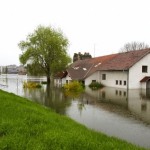Discovering a flooded apartment is an unsettling event that no one wishes to encounter. Whether the cause is a burst pipe, heavy rainfall, or any other unexpected circumstance, such incidents can be highly disruptive and have the potential to cause significant damage to your possessions. In this comprehensive guide, we will delve deeply into the intricate process of dealing with apartment floods, explore common causes of such incidents, estimate the timelines for repairs, and address the crucial issue of responsibility for water damage to tenant property, with a specific emphasis on the essential aspect of flood cleanup.
Can Pipes Burst in an Apartment?
Pipes in apartment buildings are susceptible to bursting, and several factors can contribute to this issue. Common culprits include:
- Freezing Temperatures: In colder climates, water within pipes can freeze, causing it to expand and potentially leading to pipe bursts, a frequent occurrence during winter months.
- Aging Infrastructure: Older apartment complexes are more prone to plumbing issues due to years of wear and tear on their systems, making them susceptible to leaks and pipe bursts.
- High Water Pressure: Excessive water pressure can strain pipes, causing cracks and eventual bursts.
- Corrosion: Pipes can corrode over time, weakening their structure and making them more vulnerable to leaks or bursts. Regular maintenance is essential for prolonging their lifespan.
- Neglected Maintenance: Neglecting routine maintenance can lead to problems like clogs, leaks, or burst pipes. Preventive measures and timely repairs are critical.
What to Do When Your Apartment Floods?
Discovering a flooded apartment can be a stressful experience, but taking prompt action is essential to minimize damage and ensure your safety. Here’s a step-by-step guide on how to respond when your apartment floods, while considering the importance of water damage restoration services, water damage repair, and flood cleanup:
- Prioritize Safety: Your top concern should be the safety of yourself and your family. If the flooding poses a significant safety risk, evacuate your apartment immediately.
- Locate the Source: If the flood is due to a burst pipe, try to find and shut off the main water valve in your apartment. Turning it off will stop the water flow. If you can’t locate the valve or it’s not working, contact your landlord or building maintenance immediately to arrange water damage repair.
- Protect Your Belongings: If the situation allows, move valuable or delicate items to higher ground to prevent further damage. Use towels or containers to confine the water within the affected area. This step is crucial for minimizing the extent of damage and the need for water damage restoration services.
- Document the Damage: Thoroughly document the extent of the flooding and any harm to your personal property by taking photographs or videos. This documentation is essential for insurance claims, water damage repair, and potential legal matters.
- Notify Your Landlord: Reach out to your landlord or property management as soon as possible to report the issue. Provide them with comprehensive information, including the cause of the flood, and inquire about their plans for flood cleanup and water damage repair.
- Contact Your Insurance: If you have renter’s insurance, contact your insurance provider to initiate a claim for water damage restoration services and repair. They will guide you through the process of documenting and assessing the damage.
How Long Does It Take to Fix a Flooded Apartment?
The time required for repairing a flooded apartment can vary based on several factors, including the extent of damage, contractor availability for water damage repair and cleanup.
- Severity of the Damage: The extent of flooding significantly influences the repair timeline. Minor leaks can be addressed within hours, while extensive flooding may require several days or even weeks for a comprehensive water damage repair, including basement flood cleanup.
- Contractor Availability: The availability of contractors, plumbers, and professionals specializing in water damage restoration services can impact the speed of repairs. Seasonal variations and local emergencies may result in delays.
- Landlord Responsiveness: A responsive landlord or property management team plays a vital role in expediting the repair process. A proactive approach is essential for prompt water damage repair and basement flood cleanup.
- Insurance Process: If you’ve filed an insurance claim for water damage restoration services, the processing time may vary. The insurance company will need to assess the damage, which can affect the overall repair timeline.
- Regulatory Requirements: Specific regulations or permits may be necessary for certain repairs. Compliance with these rules is essential and can extend the time required for water damage repair and basement flood cleanup.
- Restoration and Drying Time: After addressing the source of flooding, thorough drying and restoration of the affected areas are vital to prevent mold growth and structural damage. This phase significantly contributes to the overall repair duration, particularly in the context of water damage restoration services.
Is the Landlord Responsible for Water Damage to Tenant Property?
The responsibility for water damage to tenant property depends on various factors, including the cause of the damage and the terms of your lease agreement:
- Landlord Responsibility: Typically, landlords are responsible for repairing the source of the flooding, particularly if it results from a maintenance issue such as a burst pipe. This responsibility extends to any damage sustained by the apartment’s structure. However, it’s important to note that landlords usually do not bear responsibility for damage to a tenant’s personal property, emphasizing the importance of tenants having their renter’s insurance for water damage restoration services and repairs.
- Lease Agreement Terms: The specifics of your lease agreement can influence the allocation of responsibility for damage. Some leases may contain clauses that outline who is responsible for particular types of damage. Always review your lease for precise details, especially concerning water damage repair.
- Negligence or Fault: In cases where the flooding results from the landlord’s negligence or failure to address a known issue, they may be held accountable for both property damage and structural repairs. Conversely, if the flooding is due to tenant negligence, such as leaving a faucet running, the tenant may be responsible for any resulting damage.
- Insurance Claims: Tenants are encouraged to file a claim with their renter’s insurance for water damage restoration services to cover personal property damage. Landlords typically have their property insurance to cover structural repairs and flood cleanup.
To sum it up, when you’re confronted with a flooded apartment, it’s crucial to respond promptly and effectively. Your top priority is ensuring your safety. Once you’ve established that, make sure to inform your landlord, contact your insurance provider, and meticulously document the damage.
For the best results and to guarantee a thorough and successful recovery, it’s often in your best interest to get in touch with water damage restoration professionals. These experts possess the experience and tools required to manage the situation, from evaluating the extent of damage to executing comprehensive restoration, including essential flood cleanup.
So, when you’re contending with the aftermath of a flooded apartment, don’t hesitate to reach out to water damage restoration professionals. They can make a significant difference in the outcome, assisting you in reclaiming the comfort of your home.



